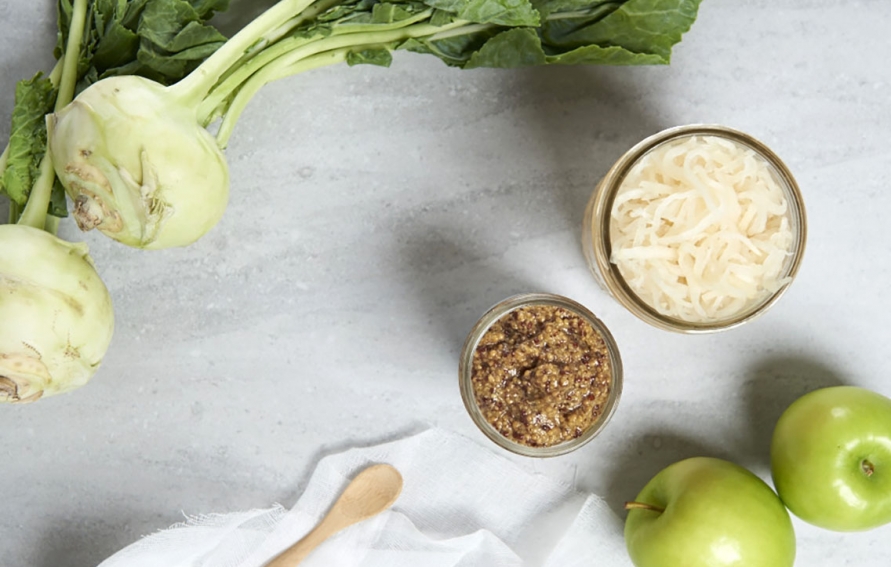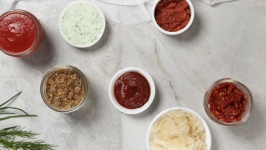Instructions
Kohlrabi Kraut
3 large kohlrabi, peeled
1 to 2 apples (optional), peeled and cored
sea salt or kosher salt
Before beginning ensure you have a large food-safe container (ceramic or glass) for the kraut, allowing headroom for the swelling of the mixture during fermentation. Weigh the kohlrabi (and the apple, if using,) and then weigh out two per cent of the kohlrabi’s weight in salt.
Using a mandolin or a sharp knife, julienne the kohlrabi and the apple and place into a clean large bowl. With clean hands, massage the salt into the julienned pieces. Let the mixture rest for a few minutes for juices to develop, then mix again. Transfer the young kraut to the food-safe container or fermentation crock, and pack tightly, so the shreds are completely covered. Do not worry if the kraut is not completely covered at first — the salt will continue to draw water from the kohlrabi, creating more brine. It may also be necessary to weigh the kraut down in order to keep it submerged. If after a day, the kraut is still not completely covered, whip up a two per cent salt brine (1gram of salt to 50 millilitres of water) and pour over to cover. Cover the container and place in a cool environment (under 18C is preferable), checking the container every few days for mould or scum. Skim off scum, if necessary. The rate at which the kraut ferments depends on the ambient temperature. Higher temperatures increase the rate, hastening the production of lactic acid, souring the kraut more quickly. Taste often, until a desirable flavour is achieved. Transfer the kraut to the fridge or to cold storage. It will continue to ferment slowly and develop flavour.
Kraut-Brine Mustard
Typically mustard seeds are soaked in vinegar, wine or beer, to produce the spicy condiment. By using mature sauerkraut brine as a replacement, this live mustard incorporates lactic acid bacteria, providing additional health benefits as well as extending its shelf life.
1 cup yellow mustard seeds or a mix of yellow and brown (brown adds more heat)
1 1/3 to 1½ cups mature sauerkraut brine (or any lactofermented vegetable brine)
3 tablespoons raw honey, or maple syrup
sea salt or kosher salt, to taste
Combine all the ingredients, except the salt, in a large glass jar (12 ounces or larger) and stir to combine. Loosely cover the jar with a lid or cheesecloth, and leave to ferment at room temperature for 2 to 3 days. Check the flavour of the mustard. The tanginess will vary depending on the initial lactic acid content of the brine and the temperature of the jar’s location. Ferment longer for more acidity, checking periodically, until satisfied. Pulse with a hand-blender or food processor to achieve a desirably textured finished product and season with salt to taste. Store the mustard in the refrigerator. The mustard will last for months and the heat will mellow over time.





